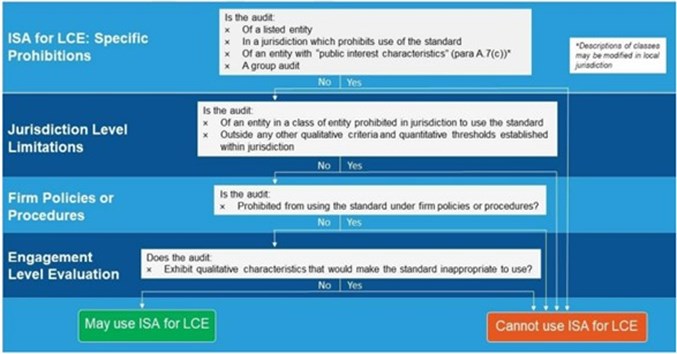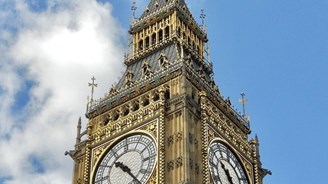Does the scope of the [Draft] Audit of Less Complex Entities (LCEs) standard work?

There are two board limitations to using the standard:
- Specific classes of entities for which the [draft] standard are prohibited;
- Qualitative characteristics of an entity which if exhibited would preclude the user of the [draft] standard.
Firm policies or procedures and additional jurisdictional limitations may also be relevant when deciding whether the [draft] standard can be used.
Both of the above need to be considered.
The IAASB have debated the scope of the standard at length and the above is designed to obtain a balance between being too prescriptive and allowing too much judgment in determining whether the proposed standard is appropriate to use. Although there would inevitably still be a level of judgment involved, they consider that this approach would achieve a better balance between prescription and judgement.
Some IAASB Board members remain of the view that the required level of judgment for those circumstances is too high and that a higher level of prescription is desirable and this is an area where the IAASB is seeking specific input.
The following flow chart is included in the IAASB explanatory memorandum:

Prohibitions
Specific prohibitions
- If law or regulation:
- Explicitly prohibits the use of the [draft] ISA for LCE; or
- Specifies the use of auditing standards other than the [draft] ISA for LCE for an audit.
- If the entity is a listed entity*.
- If an entity displays ‘public interest characteristics’^
- If the audit is an audit of group financial statements# (This does not prohibit the use of the [draft] standard for subsidiaries of groups although complexities could arise from the group auditors).
- The nature of the business or activities of the entity, such as those entities taking on financial obligations to the public as part of an entity’s primary business; and
- Entities subject to regulatory supervision designed to provide confidence that the entity will meet its financial obligations.
# Group audits are excluded are they inherently exhibit characteristics of complexity not aligned with the intended use of the [draft] standard and have not been contemplated in its the design
Qualitative characteristics
Professional judgement is used to determine whether the [draft] standard is appropriate.
It would be inappropriate for an audit to be undertaken using the [draft] standard if the entity exhibits the following:
- Complex matters or circumstances relating to the nature and extent of the entity’s business activities, operations and related transactions and events relevant to the preparation of the financial statements.
- Topics, themes and matters that increase, or indicate the presence of, complexity, such as those relating to ownership, corporate governance arrangements, policies, procedures or processes established by the entity.
It is suggested that the presence of one ‘complexity’ characteristic exhibited by an entity does not necessarily exclude the use of [draft] ISA for LCE for that entity and that the matters described in the list are intended to be considered both individually and in combination.
Business Activities, Business Model or Industry
- Products and services that may result in technological obsolescence, legal liability or reputational risk.
- Entity operates in a new or emerging market or is in the start-up or development stage of its life cycle.
- Organisational structure involves multiple level of reporting lines, with many individuals involved in financial reporting to accommodate the business activities, or includes unusual entities or arrangements (eg. special-purpose entities, complex joint ventures, off-balance sheet or other complex financing arrangements).
- Ownership or oversight structures are complex.
- Entity’s operations are subject to a higher degree of regulation or to significant regulatory oversight (eg. subject to prudential regulations).
- Transactions are complex or the information system and related processes relevant to the entity’s financial statements are complex such that the data collection and processing involves complex accounting or calculations.
- Entity’s IT environment or IT systems are complex, such as when the IT environment and processes involve highly-customized or highly-integrated IT applications, with internal resources or external service providers that have software development and IT environment maintenance skills to support the IT environment and processes.
- Entity’s accounting estimates are subject to a higher degree of estimation uncertainty or the measurement basis requires complex methods that may involve multiple sources of historical and forward-looking data or assumptions, with multiple interrelationships between them.
Implications for the UK
In the absence of a global definition of PIEs, the IAASB has described the classes of entities that would typically exhibit public interest characteristics for the purpose of determining the appropriate use of ED-ISA for LCE (with the ability to make limited modifications to these classes of entities) and prohibited those that are listed entities.
It should be remembered that supplementary guidance to the [draft] standard is clear in that:
- Adding a class of entities to the list of prohibited entities.
- Permitting specific sub-sets within a class to be able to use the [draft] standard.
- Using quantitative thresholds to prohibit use of the [draft] standard for certain entities”
In allowing jurisdictions to modify those classes of entities described in the prohibitions or the ability to further prohibit entities from using the standard, the IAASB recognizes that there may be different circumstances in some jurisdictions that need to be taken into account. Modifications can only be made within a specific class – a whole class cannot be removed.
Most auditors agree that it would not be practicable for the IAASB to define exemption thresholds or other criteria about what may constitute an audit of an LCE that would be capable of consistent global application because of, for example, the varying sizes of economies and sophistication of jurisdictions.
However, the IAASB recognized that specific thresholds or criteria could be used by individual jurisdictions when evaluating the use of ED-ISA for LCE for that jurisdiction. Such exemptions may therefore be added at the jurisdiction level.
Although there is a clear list of prohibitions / scoping in the [draft] standard which would be applicable at the International level, if the FRC choose to adopt the standard in the UK, then further amendments could be made to the scoping of the standard. It is more than likely that the FRC would consult on any changes to the scoping.
The prohibition of group audits has been a key area discussed at the ICAEW LCE working group meetings and it is felt by many that this exclusion may be going to far. There are many groups set up in the UK which are separate legal entities but run more akin to one company with various branches.
These types of groups are often simple in their nature and questions around whether / how groups could be included in the scope of the standard has been a key topic for discussion. Instead of a direct prohibition here, perhaps an assessment of the qualitative conditions (see below) of the group would be key in understanding whether the proposed standard should be applicable.
There are further complexities on groups if they remain prohibited but the subsidiaries are audited under the [draft] LCE standard. At present, there is no clarity over how the group auditors will deal with this and whether tensions may arise due to auditing under different standards.
An additional complexity is that the IAASB note that if further changes are made to the description of the scope of a group audit, the impact of those changes, if any, will be considered as ED-ISA for LCE is finalized (eg. it does not appear that they will re-expose the [draft] standard for comments).
Given this could be quite a substantial edit, it is my thoughts that a re-exposure would not just be sensible but absolutely necessary.
What should you be doing?
If you are an auditor in the UK and are frustrated with how the ISAs are currently written, then now is your time to have a say. While the IAASB encourages all interested stakeholders to respond to the consultation in writing, it recognizes that some may not have the time or resources to do so.
To help, the International Federation of Accountants (IFAC) and the IAASB developed a survey to offer an alternative way to participate in the consultation and provide your views.
The survey is open until January 14, 2022.




